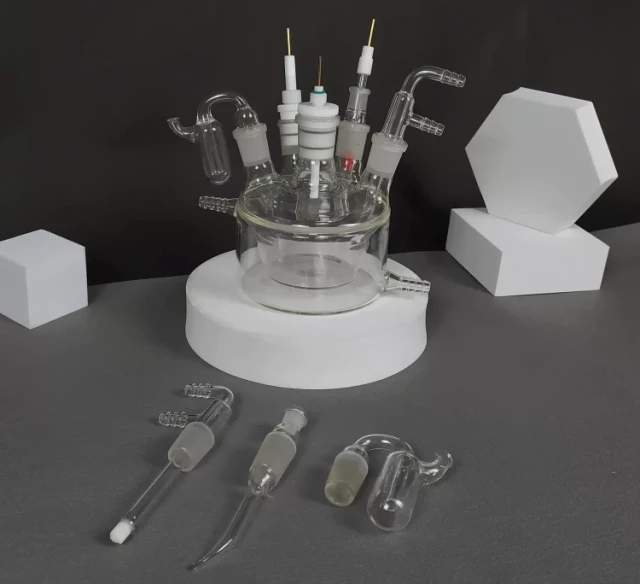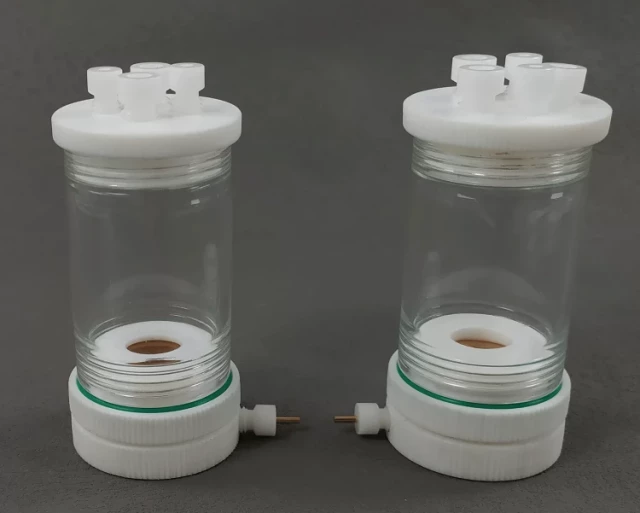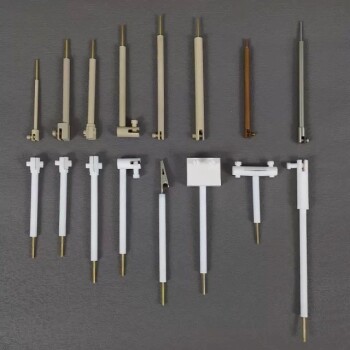Introduction to Electrochemical Electrodes
Electrochemical electrodes are essential tools used in many chemical analysis techniques and experiments. These electrodes are devices that allow us to measure the electrical potential difference in a chemical reaction. The most common types of electrochemical electrodes are reactive and inert electrodes. Reactive electrodes participate in the electrochemical reaction, while inert electrodes are used as a reference point for the potential difference measurement. Electrodes are crucial in potentiometric analysis, where they are used as indicator electrodes.
Table of Contents
Types of Electrodes
Electrodes are important components of electrochemical cells, and can be made from a variety of materials such as gold, platinum, carbon, graphite, and metals. When it comes to electrochemical analysis, there are different types of electrodes that can be used depending on the specific ions or molecules being measured.

Reactive Electrodes
Reactive electrodes are electrodes that take part in the reaction taking place in the cell and can disassociate in the electrolyte. The passage of electricity takes place through ion exchange. Examples of reactive electrodes include copper, silver, and gold.
Inert Electrodes
Inert electrodes, on the other hand, are electrodes that do not interfere or participate in any chemical reactions and are still used to transfer electricity by passing electrons through the solution instead of exchanging ions. Examples of inert electrodes include graphite, platinum, gold, and rhodium.
A bipolar electrode is another type of electrode that takes on the role of an anode of one cell and a cathode of the nearby cell. The electrode cannot be permanently established because it can take the character of an anode or cathode, depending on the electron flow direction.
Regardless of the type of electrode used, it's important to note that an electrode can take on the role of an anode or cathode, depending on the electron flow direction. For instance, the cathode is negative as the electrical energy that is contributed to the cell results in the decomposition of chemical compounds. However, in the case of a galvanic cell where a chemical reaction leads to the production of electrical energy, the cathode can also be positive.
In conclusion, the choice of electrode used in an electrochemical analysis depends on the specific ions or molecules being measured, as well as the desired sensitivity and accuracy of the analysis. Proper selection and use of electrodes is essential for accurate and reliable electrochemical analysis.
Electrodes in Quantitative Analysis
Electrochemical electrodes are essential tools in chemical analysis and have contributed significantly to our understanding of the chemical properties of various substances. Electrodes are used to measure the concentration of ions in a solution, pH levels, and the reduction or oxidation potential. The most commonly used electrodes in chemical analysis are the pH electrode, the reference electrode, and the working electrode.

pH Electrode
The pH electrode measures the acidity or basicity of a solution. The pH of a solution is determined by the concentration of hydrogen ions (H+) in the solution. The pH electrode consists of a glass membrane that is sensitive to changes in the concentration of H+ ions. The glass membrane is coated with a thin layer of silver chloride, which acts as a reference electrode. When the glass membrane comes into contact with a solution, a potential difference is created between the reference electrode and the solution, which is proportional to the concentration of H+ ions in the solution.
Reference Electrode
The reference electrode provides a stable reference potential for the working electrode. The reference electrode is often made of an electrode material that has a stable, well-defined potential, such as silver/silver chloride or saturated calomel. The potential of the reference electrode does not change, and it serves as a constant reference point for the working electrode.
Working Electrode
The working electrode is used to generate a current or potential that is proportional to the concentration of the analyte in the sample. The working electrode is typically made of glass, metal, or carbon. The choice of electrode material will depend on the nature of the sample to be analyzed and the specific properties of the analyte.
Disk Electrodes
Disk electrodes are one of the essential components for performing many electrochemical experiments. Disk electrodes are circular with a small ring around the edge, and they can be made to rotate to encourage stirring and measure the rate of solution flow in an experiment. The advantage of using disk electrodes is that the diffusion behavior of the electrode is different from a standard hemispherical structure, and the flux can be higher. Some disk electrodes can be micromachined to a very small size and are commonly used for cost-efficient disposable electrodes.
Applications of Electrodes in Quantitative Analysis
Electrochemical electrodes are widely used in industries such as pharmaceuticals, food and beverage, and environmental monitoring. Electrodes are used to measure the concentration of ions in a solution, pH levels, and the reduction or oxidation potential. The use of electrochemical electrodes in chemical analysis has revolutionized the field of analytical chemistry and has allowed for more accurate and precise measurements of chemical species in various samples.

Overall, electrochemical electrodes have been widely used in the field of chemical analysis for many years and play a crucial role in quantitative analysis. The pH electrode, reference electrode, and working electrode are the most commonly used electrodes in chemical analysis, and disk electrodes are essential components for performing many electrochemical experiments.
Potentiometric Analysis
Potentiometric analysis is a widely used method in chemical analysis, particularly in the determination of the concentration of ions or molecules in a sample. This method involves measuring the potential difference between two electrodes, one of which is a reference electrode, while the other is a working electrode that reacts with the analyte.
Working Electrode
The working electrode is typically made of a metal or metal oxide that undergoes an oxidation or reduction reaction upon exposure to the analyte. It is where the current that passes to or from the electrode is recorded by the potentiostat. For cyclic voltammetry experiments, it is helpful to know the area of the working electrode, which can come in a variety of shapes, but it is usually a flat surface.
Reference Electrode
The reference electrode maintains a constant potential to serve as a baseline for the working electrode's potential. The potentiostat limits the amount of current that can pass between the reference electrode and the working electrode to nearly zero. The reference electrode is the electrode to which the potential of the working electrode is referenced. Some reference electrodes consist of redox systems for which the absolute potential is known, but the only real requirement of a reference electrode is that its potential remains constant for the duration of the experiment.
Ion-Selective Electrodes
Ion-selective electrodes are another type of potentiometric electrode that selectively bind to specific ions. These electrodes are made up of an ionophore, which selectively binds to a specific ion, and a reference electrode. The potential difference generated between the two electrodes is proportional to the concentration of the ion of interest in the sample. Some examples of ion-selective electrodes include pH electrodes, which measure the concentration of hydrogen ions in a solution, and fluoride ion-selective electrodes, which measure the concentration of fluoride ions in a sample.
Advancements in Electrode Technology
Advancements in electrode technology have led to the development of miniaturized, disposable, and portable electrodes, making potentiometric analysis more accessible and convenient. However, proper calibration and maintenance of electrodes are crucial to ensure accurate and reliable results.
Overall, potentiometric analysis is a powerful tool in chemical analysis, enabling precise and sensitive detection of various analytes in a range of applications. It is widely used in various fields, including medicine, environmental monitoring, and the food industry.
Indicator Electrode
Indicator electrodes are utilized in electrochemical measurements to identify changes in the chemical composition of a solution. These electrodes are one type of electrochemical electrode that is used to measure the electrical potential of a solution. They consist of a metal or metal oxide coated with a thin layer of electrode material. The material is sensitive to changes in the solution and reacts with it to produce a change in electrical potential that can be measured using a reference electrode.
How Does an Indicator Electrode Work?
Indicator electrodes are designed to detect changes in the chemical composition of a solution. They are sensitive to changes in the activity of the analyte and respond by generating a change in the electrode potential. The potential change is then measured using a reference electrode to provide a quantitative measurement of the analyte.
Types of Indicator Electrodes
There are different types of indicator electrodes, and each is used to measure specific ions or molecules. The most common type of indicator electrode is the pH electrode used to determine the concentration of hydrogen ions in a solution. Other types of indicator electrodes include those used to measure the concentration of specific ions such as fluoride or chloride ions.
pH Indicator Electrodes
pH indicator electrodes are widely used in laboratory analysis. They consist of a pH-sensitive membrane that responds to changes in the concentration of hydrogen ions in a solution. The membrane is typically made of glass or a polymer and is coated with a thin layer of an ion-sensitive material. When the electrode comes into contact with a solution containing hydrogen ions, the ions diffuse through the membrane, and the electrode potential changes. The potential change is then measured using a reference electrode to determine the pH of the solution.
Other Types of Indicator Electrodes
Other types of indicator electrodes include fluoride and chloride ion electrodes. Fluoride ion electrodes are used to determine the concentration of fluoride ions in a solution, and they are typically made of a fluoride-sensitive membrane coated with a thin layer of a fluoride ion-sensitive material. Chloride ion electrodes are used to determine the concentration of chloride ions in a solution, and they are typically made of a chloride-sensitive membrane coated with a thin layer of a chloride ion-sensitive material.
Overall, indicator electrodes are an essential tool in chemical analysis, providing accurate and reliable measurements of the chemical composition of a solution. These electrodes are widely used in laboratory analysis and are available in different varieties to measure specific ions or molecules.
Conclusion
In conclusion, electrochemical electrodes play a significant role in chemical analysis. They are critical components of electrochemical cells and are used to measure various parameters such as pH, ion concentration, and oxidation-reduction potential. The type of electrode used depends on the application, with reactive electrodes being used for redox reactions, and inert electrodes being used for measurements such as pH. The potentiometric analysis using electrodes has revolutionized chemical analysis by enabling the measurement of ion concentration in solutions accurately. In summary, electrochemical electrodes are versatile tools that have a wide range of applications in the field of chemical analysis.
Related Products
- Rotating Platinum Disk Electrode for Electrochemical Applications
- Gold Electrochemical Sheet Electrode Gold Electrode
- Electrolytic Electrochemical Cell for Coating Evaluation
- Gold Disc Electrode
- Electrode Fixture for Electrochemical Experiments














